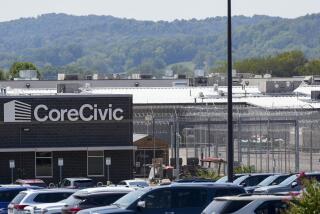Prisons Ordered to Pay Doctors
- Share via
SACRAMENTO — Managers of California’s beleaguered prison system received a double dose of bad news Thursday as a federal judge ordered them to pay tens of millions of dollars owed to doctors who treat inmates, and the state launched an audit of their agency.
Some of the doctors have not been paid in four years. Some of their contracts have lapsed. And some who deliver cardiology, radiology, oncology and a wide range of other services to prisoners are no longer responding when called.
U.S. District Judge Thelton E. Henderson, who recently put the state’s prison healthcare system in the hands of a federal receiver, ordered that outstanding doctor bills, which total more than $58 million, be paid within two months.
Henderson also had harsh words for corrections leaders, saying they have stuck “their collective heads in the sand” instead of resolving the medical contracting mess.
“Predictably,” he said, “this stunning example of the state’s bureaucratic inaction ... is now culminating in a crisis.”
State Controller Steve Westly also weighed in, saying that his office will audit the Department of Corrections and Rehabilitation to determine why prison healthcare is so poor despite a doubling of funding since 2000.
Lax medical care in California lockups is blamed for an average of 64 preventable deaths a year. Disturbed by the deaths and the lack of progress in resolving the healthcare problems, Henderson named the federal receiver to take over inmate medical care -- a $1.2-billion-a-year operation -- earlier this year.
“The taxpayers have nothing to show for the billions spent on prison healthcare,” said Westly, a Democratic candidate for governor. “Instead, we’ve seen the first federal takeover of a state agency in California history. My audit will get to the bottom of this management meltdown and ensure that the people of California get a full accounting of their tax dollars.”
Westly said that according to the Kaiser Family Foundation, it costs $3,850 per year to provide health insurance to the average California worker. The state spends $7,000 per inmate per year on healthcare, he said.
Doctors and lawyers who represent inmates applauded the judge’s order, saying that it would save lives. But one physician who has treated inmates for a decade, Dr. John G. Henry, said the prisons could have trouble hiring outside doctors in the future because of the delinquent payments.
Henry, a general surgeon in Templeton, about 20 miles north of San Luis Obispo, said he had not been paid since September. Inmates at Avenal State Prison in the San Joaquin Valley make up about 40% of his caseload. Until recently he was performing about 20 surgeries a month on prisoners with gallstones, appendicitis, hernias and the like.
But about six weeks ago, the anesthesiologists at Twin Cities Community Hospital in Templeton stopped taking inmate cases -- except emergencies such as appendectomies -- because of nonpayment by the state. Henry had to follow their lead.
“I won’t tell you how much I’m owed, but it’s a lot,” Henry said. “Nobody wants to stop providing care, but this is ridiculous. We can’t keep working for free.”
In a statement, the department’s healthcare chief, Peter Farber-Szekrenyi, said officials had been working for six months to “streamline” the contracting process and payment of medical providers.
He said he looked forward to working with receiver Robert Sillen to comply with the judge’s order, which also directed that the state alter its contracting procedures and hire and train analysts to monitor contracts and ensure that doctors get paid on time.
A lawyer with the Prison Law Office, a nonprofit firm whose lawsuit over inmate healthcare led to the receivership, said the judge’s order had come none too soon.
In visits to several prisons recently, attorney Steve Fama said he learned of scores of inmates who had been approved for visits to outside specialists but could get no appointments because of contract disputes.
In one case, a doctor who saw an inmate at the state prison in Lancaster found a large tumor that was causing “massive destruction of the left hip,” Fama said, quoting from a doctor’s report. The physician called it a problem of “great magnitude” and referred the inmate for an immediate visit to an oncologist.
“But five weeks later, they still couldn’t get an appointment,” Fama said.
The situation was as dire at Salinas Valley Prison when he visited the facility March 1, Fama said. Records showed that among those patients with “extremely serious” conditions still awaiting appointments were three with cardiac problems, two with lung masses and two with infectious disease symptoms, he said.
More to Read
Get the L.A. Times Politics newsletter
Deeply reported insights into legislation, politics and policy from Sacramento, Washington and beyond. In your inbox three times per week.
You may occasionally receive promotional content from the Los Angeles Times.










